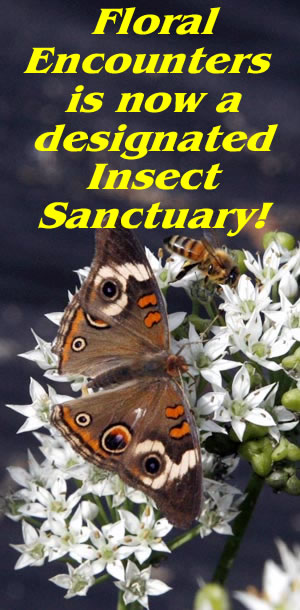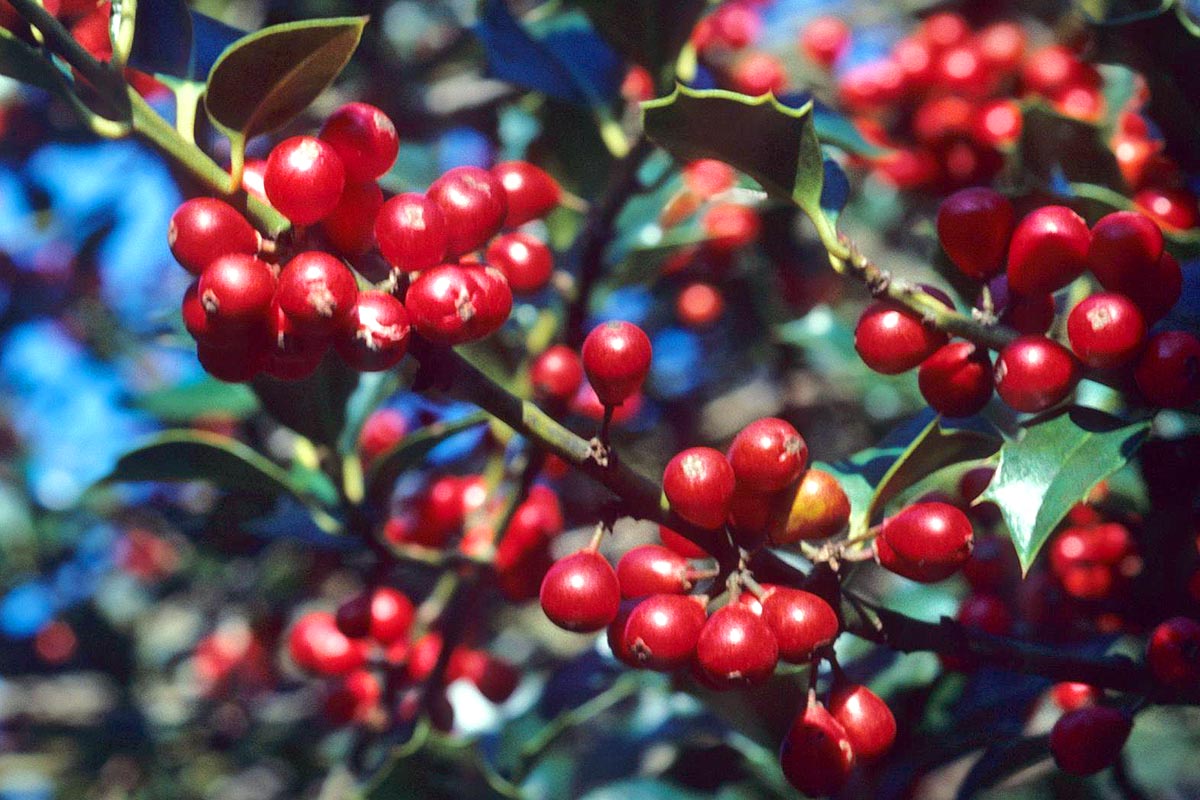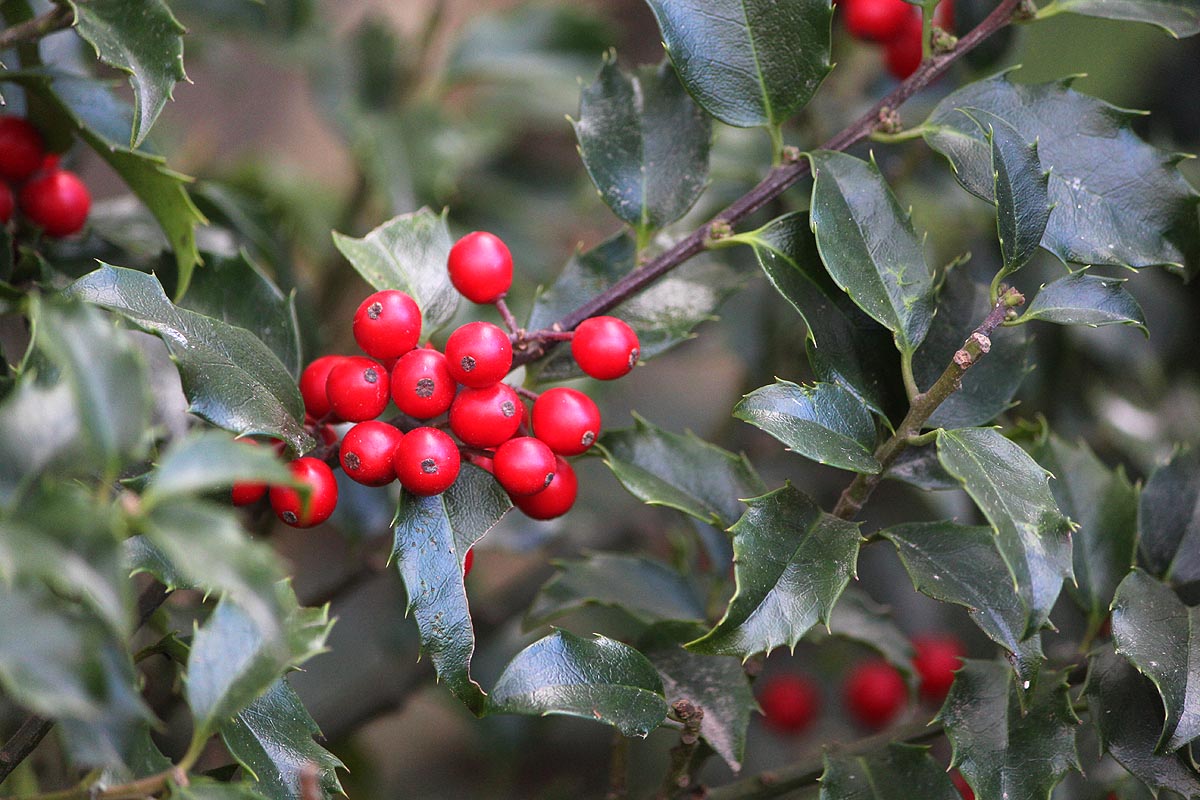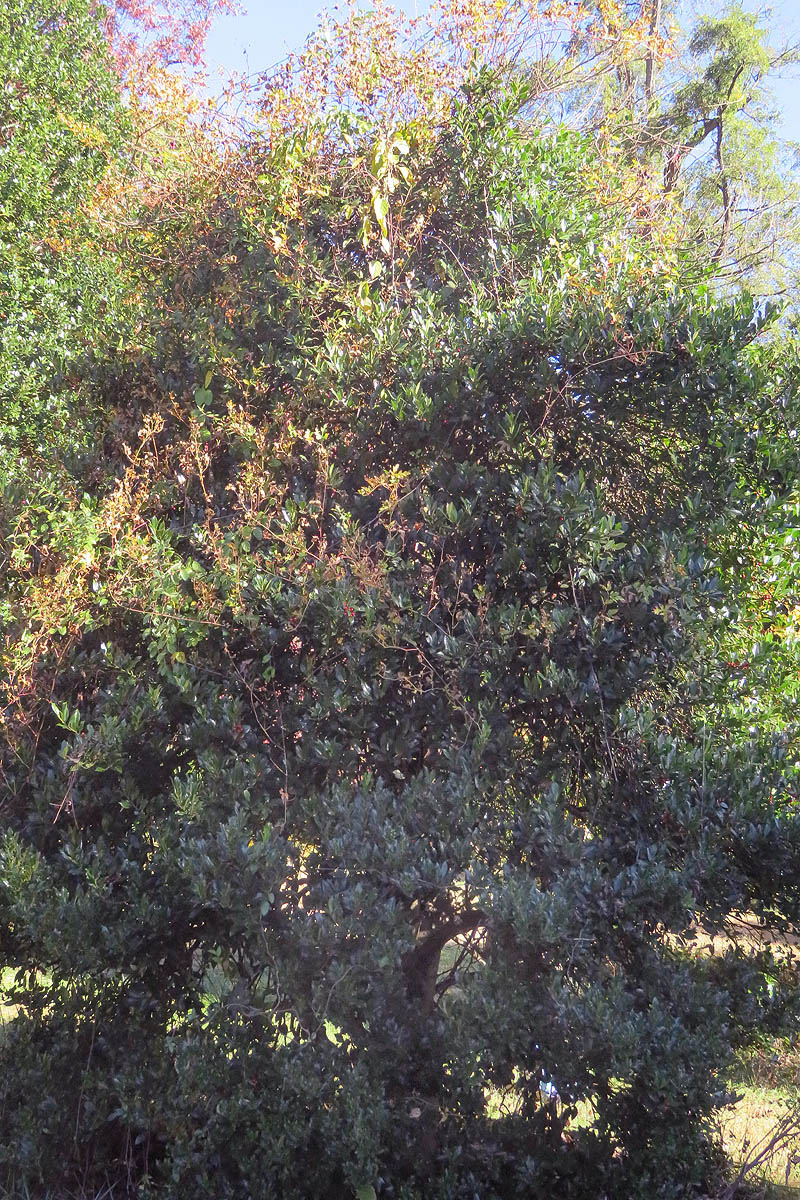The spiny leaves make it an excellent deterrent for almost any creature so its good as a security fence as well as being avoided by deer and other browsing animals. Grows on most soil types, its not fussy. It will also grow in shade making it ideal for semi open forest understory although the shape may be more open as shade increases.
Holly is dioecious, meaning it has both male and female trees, both are needed to get the females to produce the showy berries. However if screening, fencing or wind reduction is the requirement then berries are just an added bonus. English holly produces a deep tap root and does not like to be moved once its established but it also makes it fairly drought tolerant once it reaches this stage. Does need a well draining soil but one with some organic material will produce a much happier tree. The main downside is its a stubborn germinator needing quite a bit of cold warm cold before it will sprout.
The leaves basically elliptical, leathery, dark green in color and glossy up to 3 inches (7.6cm) long and half as wide. They are crinkled with deep wavy margins with each point harboring a hard spine in the leaves at the base of the tree where protection from predators is required. Further up the tree the spines disappear and leaves have more smooth margins.
Holly trees are dioecious, which means there are male and female trees. Only the females produce bright red berries but sexes of tree are required to obtain them. The flowers of both sexes are small about 5mm across with four white ovate petals which open in a flat plane. Male flowers have four large stamens standing upright in the center of the flower with large pollen pads on each. The females are much smaller stamens around the large central green stigma. Petals can be tinged with pink and are grouped in large clusters at or near the ends of the branches arising from the leaf nodes. They are very fragrant and although may not be seen the aroma will certainly be noticed. Fertilized flowers are followed by bright red berries 0.25 inches (5mm) in diameter that are very showy.
While this tree is often reported as slow growing, this is not true in all zones, it will depend on the light levels. In more northern European zones it does grow slowly in more southern zones, in good light, it can grow quite rapidly at first up to 5 feet (1.5m) a year then slowing as it reaches about 8 feet (2.4m).
It is impossible to tell the sex of a tree until it flowers and of course both sexes are needed to produce berries. It is therefore essential to have more than one tree if berries are desired. Once trees have flowered excess males can be removed if desired. Trees can take anywhere from 2-7 years to flower depending on zone and light location.
How you tackle your seeds will depend on how much work you are willing to put into the process.
If you choose this method it can be started in the winter if desired. Even if the ground is frozen provided you have a tool that can make a hole to get the seed into and cover it up again!
Hollies dont like to be moved so pick your location carefully and Mark It. Otherwise you may forget that you planted your seeds here.
Space seeds about 4 feet apart and bury about 3/4 inch (1.7cm) down. If you have time in advance and its not too cold, remove all the weeds and other debris before you start.
Then you wait 18 months! Make sure you remember where you planted the seeds and keep an eye on it. Once hollies germinate they grow quite quickly if there is sufficient light.
We recommend all seeds purchased before April be kept in the refridgerator to ensure that sufficient cold as been achieved. Seeds can be started before that time that is your choice.
After the first cold period we need to.
You will need
1. A sheet of course sandpaper, pick a good brand, inexpensive ones tend to break down too fast.
2. A course sanding sponge.
Place the seeds a few at a time, we recommend not more than 3-4 on the sandpaper. Use the sponge to rub hard and scrape the seeds over the paper.
This method allows you to push quite hard and scrape the seeds without hurting your hands. We have found it very effective.
If you choose to leave the pots outside during the summer make sure they are located where you can keep an eye on them. Shade or semi shade is best not in full sun for any part of the day. Dont let them dry out and protect them from rodents and birds that may come and eat the seeds. The main disadvantage of leaving outside is that weed seeds will almost certainly land and start to germinate so they need to be kept weed free while ensuring you dont pull out your seedlings.
Its possible some of the seeds may germinate at this time so keep an eye on them but dont rely on this happening.
If you live in an area where winters are cold enough place pots inside the transparent plastic bag to keep them moist and leave in a cold outbuilding such as a shed or garage. Place near a window if you have one. This keeps them in better controlled conditions. Remember to label them so you know what they are come spring.
If your zone does not have temperatures that are cold enough you will need to wrap the pots and place in the refridgerator for at least 60 days. This is where using egg boxes comes in best as they store well and dont take up too much space. Use the transparent kind so you can see what is happening inside. Wrap the whole egg box in a thin plastic bag so they dont dry out.
If you used an egg box carefully remove each dimple of soil with a spoon and transplant to a larger pot one seed to a pot. Once they have germinated grow on and repot if the roots are seen coming from the bottom.
Use deep pots. Hollies create tap roots and so deep roots they will often put down deep roots before they show much in the top growth. Using a deep pot for your little seedlings helps this. You can make your own deep pots from cardboard half gallon juice or milk containers. Use only ones that have held food other substances may inhibit the growth or even kill the seedlings. Gallon containers can be used but may reduce growth as they are too large. Remember to punch a few holes in the bottom of the container for drainage.
Keep pots in a semi shaded area until the germinate then gradually introduce the new plants to full sunshine but only in cooler zones. See location notes below. Keep moist at all times.
Once your seedlings have grown to about 3 inches in height they most likely have a good root system and can be transplanted to their new home. If you see roots coming out the holes at the bottom of your pots then transplant earlier.
Hollies dont like their roots disturbed so keep the soil together as much as possible. Dig a hole the same size and depth as your cardboard pot.
Use a knife to cut away the cardboard pot from the soil and drop the whole thing into the hole intact. This keeps the roots happy.
Protect young seedlings from browsing for wild animals. Once the roots become established the trees grow very rapidly as much as five feet in one year depending on your zone and the amount of light the seedling gets.
Think carefully before you plant your holly once its established it wont like to be moved. While it is possible to dig up and move a very small holly bush this may only have a 30-50% success rate. They really dont like being moved. If trees are larger than 20 inches (51cm) dont attempt to move them without professional help, they will most likely die.
Soil. Tolerant of almost all soil types provided it is well drained. Cannot tolerate wet or waterlogged soils for any period of time. However it will grow in clay soils provided they drain.
Water. Will need regular watering while establishing itself but then should not need any other water unless there is a major drought. While it does prefer moist soils it is fairly drought tolerant once established. Since holly can produce very deep roots it can source water for well underground. So it can grow on dryer soils, most commonly in a woodland setting.
Temperature. Holly is zoned at 6a -9 but its not that simple. While it does not do well in cold locations it can be grown in 5b provided it is in a sheltered location. Up against a wall or in a courtyard where there is a warmer microclimate. Hollies can tolerate short periods down to 5 F (-15c). Severe frosts in such locations may kill whole branches especially in open areas.
Temperatures need to be consistently over 54 F (12C) during the summer months for good berry production. So trees where summers are cooler may not produce fruits.
Does not do well in hot humid locations. So while it may tolerate high temperatures of zone 9 when the air is dry it wont do well in the humid southeastern states.
In zones 8b and 9 it will need a open area in the shade where there is much airflow as possible to keep the trees cool during the summer months.
In zones colder than 6a hollies can be grown in large pots and used decoratively. These will need to be moved inside during the winter to a well lit location such as a greenhouse or hoop house where the pots do not freeze.
Zones 7b -9 trees need more shade. In cooler zones dappled shade, woodland edges and understory in open woodlands is ideal. More shade in 8-9 but still with lots of airflow and space.
Location. Hollies do best with lots of space. They dont like to be crowded with other trees. They need airflow and do best where they get their own room. In full sunshine and left alone hollies will produce branches down to the ground and form beautiful tall narrow pyramid shapes. The make excellent specimen trees. The lower branches can be clipped off if desired so it looks more like a regular tree and may be required in hotter zones to help with airflow. However if possible leaving the lower branches requires less work as there is no under tree cleanup and they look magnificent.
In woodland settings, depending on the amount of shade the trees can form the pyramid shape but they may produce a more open branched tree to allow for their own airflow with less light levels.
If growing as a hedge ensure there is plenty of airflow both sides of the hedge and its kept well trimmed to ensure good airflow through what is now a dense bush.
Pruning. For the most part hollies dont need pruning unless the lower branches are removed to expose the trunk. They tend to self prune and produce a pyramid shape that does not need any work. In woodland settings pruning should also not be necessary unless the tree is damaged. Prune in winter if required. Hedges can be clipped as needed.
The flowers, although not very conspicuous are very fragrant and have lots of nectar. The bees and other pollinators love them and will flock in. The berries that follow on the female trees are excellent winter food for birds.
The dense pyramid shape of the tree makes it an excellent nesting spot for birds as there is much cover and the prickly leaves help deter predators. Rabbits and other wildlife may den under the base for the same reason.
Berries can be harvested in late autumn/fall and dried for later use.
Leaves. Best harvested in late spring and dried for future use.
In earlier times the leaves, as a tea, were used to treat of intermittent fevers, rheumatism, catarrh, pleurisy. The berries are toxic especially to children and can cause violent vomiting. They can be used as a emetic and purgative in adults but not children. Ground to powder they are used externally to reduce bleeding.
The smaller branches make good fuel since they are so dense.








